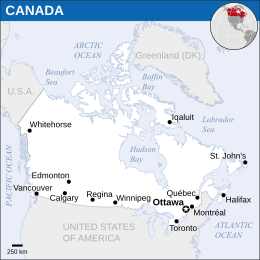(US invasion) Tag: Visual edit |
mNo edit summary Tag: Visual edit |
||
| Line 30: | Line 30: | ||
== References == | == References == | ||
[[Category:Imperialist countries]] | [[Category:Imperialist countries]] | ||
<references /> | <references /> | ||
[[Category:Global north]] | [[Category:Global north]] | ||
[[Category:Settler-colonial states]] | [[Category:Settler-colonial states]] | ||
[[Category:Countries invaded by the United States]] | |||
Revision as of 12:08, 22 July 2023
| Canada Kanada Kanata ᑲᓇᑕ Zhaaganaashiiwaki | |
|---|---|
 | |
| Capital | Ottawa |
| Largest city | Toronto |
| Official languages | English French |
| Dominant mode of production | Capitalism |
| Government | Federal parliamentary bourgeois state |
• King | Charles Windsor |
| Justin Trudeau | |
| Mary Simon | |
| History | |
| 1 July 1867 | |
| 17 April 1982 | |
| Area | |
• Total | 9,984,670 km² |
| Population | |
• 2021 estimate | 38,436,447 |
| Currency | Canadian dollar |
Canada is a settler-colonial and imperialist state in North America. Despite being a wealthy country in terms of GDP, over four million people, more than 10% of its population, do not have access to sufficient food.[1] Canada exists as an accomplice of U.S. imperialism and has supported the apartheid regimes of South Africa and Israel and the U.S. invasions of Iraq, Libya, and Haiti.[2]
History
U.S. invasion
In late 1775, the Continental Army invaded what is now Canada and captured Montréal, occupying it until the summer of 1776. It failed to take Quebec City, and General Richard Montgomery died during a siege in December 1776.[3]
1930s
During the 1930s, the anti-Semite William Lyon Mackenzie King ruled Canada and refused to allow Jewish refugees fleeing from Germany into Canada.[2]
Settler colonialism
Following colonization by the British Empire, Canada was under direct British rule until 1867. In 1876, Canada passed a law that prevented people from testifying or having their case heard in court if they did not adopt Christianity.[4] Children were prevented from speaking their native languages and forced to adopt Christianity and the culture of the settlers. Canada was one of only four countries to vote against the Declaration on the Rights of Indigenous Peoples in 2007.[5]
In 2020, indigenous people were seven times as likely to be murdered as settlers.[6] Even though they only make up 4% of the total population, natives make up 36% of imprisoned women and 25% of imprisoned men.[7]
Westward expansion
Residential schools
Canada forcibly assimilated much of its indigenous population by sending Native children into residential schools from 1831 to 1996.[8] The terrible conditions at these schools led to many deaths, and children were often buried in unmarked graves at the schools. In 2021, 751 graves were uncovered at a single school in Saskatchewan.[9] In British Columbia, two more mass graves were found, one at Kamloops with 215 indigenous children[8] and another with 182 graves at Cranbrook.[10]
Imperialism
Canada spies on its citizens as part of the Five Eyes alliance[11] and is part of the international terrorist organization NATO. It intervened in the Russian Civil War to help the monarchist White Army, invaded Korea in 1950, and invaded Libya in 2011.
Ukraine
Canada's military also trained far-right Ukrainian groups including Military Order Centuria and the neo-Nazi Azov Battalion. In 2018, Canadian officials met with the Azov Battalion but did not denounce their far-right ideology. Canada's federal government has spent over $890 million on training Ukrainian forces as part of Operation Unifier.[12]
Economy
75% of the world's mining companies are based in Canada, mostly because of the state's very lax rules on what said companies do outside of Canada.[13]
References
- ↑ Thin Lei Win (2020-01-20). "Millions go hungry in wealthy Canada - and some die young as a result" Reuters. Archived from the original on 2021-02-23. Retrieved 2022-05-22.
- ↑ 2.0 2.1 Lee Camp (2023-02-08). "Canada Is Part of the US War Machine, with Pitasana Shanmugathas" MintPress News. Archived from the original on 2023-02-10. Retrieved 2023-02-11.
- ↑ David Vine (2020). The United States of War: 'Why Are So Many Places Named Fort?' (pp. 95–6). Oakland: University of California Press. ISBN 9780520972070 [LG]
- ↑ Andrew Armitage (1995). Comparing the Policy of Aboriginal Assimilation: Australia, Canada, and New Zealand (pp. 77–78). Vancouver: University of British Columbia Press.
- ↑ UN adopts Declaration on Rights of Indigenous Peoples (2007-09-13). United Nations News Centre. Archived from the original on 2014-09-25.
- ↑ "Homicide rate for Indigenous people 7 times higher than non-Indigenous in Canada" (2021-11-26). CGTN. Archived from the original on 2021-11-27. Retrieved 2022-07-01.
- ↑ Nick Estes, et al. (2021). Red Nation Rising: 'Indian Killers' (p. 51). [PDF]
- ↑ 8.0 8.1 "Hundreds of unmarked graves found at another indigenous school in Canada" (2021-06-24). CGTN. Archived from the original on 2021-07-03. Retrieved 2022-07-01.
- ↑ "Canada: 751 unmarked graves found at residential school" (2021-06-24). BBC. Retrieved 2021-12-31.
- ↑ "182 unmarked graves discovered at another indigenous residential school in Canada" (2021-07-01). CGTN. Archived from the original on 2021-07-02. Retrieved 2022-07-01.
- ↑ James Cox (2012). Canada and the Five Eyes Intelligence Community. [PDF]
- ↑ Christy Somos (2022-04-28). "Mounting evidence Canada trained Ukrainian extremists, gov't needs to be held to account: experts" CTV News. Archived from the original on 2022-05-03. Retrieved 2022-05-22.
- ↑ Owen Schalk (2021-09-06). "Going for Gold: Neocolonialism and Canadian mining in Africa" People's Voice. Retrieved 2022-12-27.

